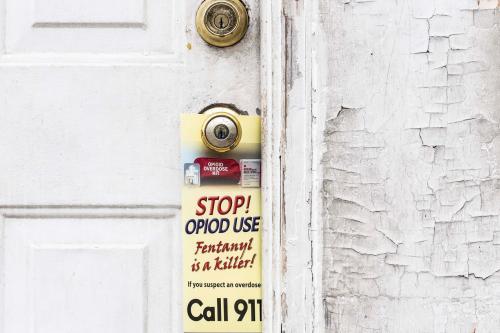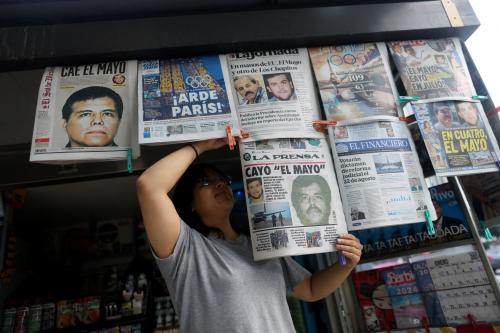Vanda Felbab-Brown testifies before the Senate Committee on Foreign Relations on “Dismantling Transnational Criminal Organizations in the Americas.” Below is her delivered testimony in full, lightly edited for style.
Dear Chairman Risch, Ranking Member Shaheen, and distinguished members of the Senate Committee on Foreign Relations:
Thank you for holding this hearing entitled, “Dismantling Transnational Criminal Organizations in the Americas.” This is a crucial issue that deserves the attention of the subcommittee and its members. I am honored to have this opportunity to submit this testimony as a statement for the record.
I am a senior fellow at the Brookings Institution, where I direct the Initiative on Nonstate Armed Actors and the Brookings series, the Fentanyl Epidemic in North America and the Global Reach of Synthetic Opioids, and codirect the Africa Security Initiative. Illicit economies, such as the drug trade and wildlife trafficking, organized crime, corruption, and their impacts on U.S. and local security issues around the world are the domain of my work and the subject of several of the books I have written. I have conducted fieldwork on these issues across Latin America as well as in Asia, Africa, and the Middle East.
The Brookings Institution is a U.S. nonprofit organization devoted to independent research and policy solutions. Its mission is to conduct high-quality, independent research and, based on that research, to provide innovative, practical recommendations for policymakers and the public. The testimony that I am submitting represents solely my personal views, and does not reflect the views of Brookings, its other scholars, employees, officers, and/or trustees.
Introduction
Transnational criminal organizations (TCOs) pose significant threats to the United States as well as to the governments and societies in the Western Hemisphere. The lethality of synthetic drugs increasingly trafficked into the United States and around the world, the violence of many criminal groups in Latin America, and the diversification of TCOs into many other illegal and legal economies beyond drug trafficking have pushed these threats to new heights.
The TCOs are constantly evolving and adapting in response to law enforcement strategies mounted against them while they take advantage of conducive political environments. Areas with poor rule of law, high corruption, unaccountable security forces, and inadequate provision of legal socio-economic opportunities for large segments of society provide particularly potent areas of operation for dangerous criminal groups.
In my testimony, I first outline the key trends in organized crime in the Western Hemisphere, then describe some of the key criminal groups operating there, and finally, lay out core policy recommendations.
Key trends in organized crime in the Western Hemisphere
Several important trends characterize organized crime groups in the Western Hemisphere and beyond:
1. The international reach of organized crime groups is expanding more than ever.
For example, Mexican criminal groups, such as the Sinaloa Cartel and the Cartel de Jalisco Nueva Generación (CJNG), operate not only in Mexico and the United States, where they are the principal wholesale suppliers of fentanyl, methamphetamine, cocaine, and other illicit drugs, but also across Latin America and increasingly Canada. In Mexico and Latin America, they are also significant sources of homicides, often instigating violence among local criminal groups over trafficking routes and hubs, drug production, and access to other illicit commodities and corruption networks.
The two cartels have also significantly increased their presence in Europe, the Middle East—such as via connections with Turkish criminal networks—Africa, Asia, and Australia and New Zealand.
Such internationalization of operations is also characterizing other rising and increasingly potent criminal groups, such as the Primeiro Comando da Capital (PCC), Brazil’s leading mafia group with reach across the Southern Cone and into over 90 countries, as Brazilian law enforcement officials conveyed to me.
Criminal groups from outside of the region are also expanding their presence in the Western Hemisphere and posing significant and multifaceted threats. They include powerful Chinese criminal groups, Indian criminal groups, and Albanian and other Balkan networks.
2. The economic activities of TCOs are increasingly diversified into a wide variety of illegal economies beyond drugs as well as legal economies.
As I detail in “China-linked Wildlife Poaching and Trafficking in Mexico“ and my many other writings on Mexico, Mexican cartels have taken over legal and illegal fisheries in Mexico, agriculture, mining, alcohol and cigarette retail, and various other economies. Their increasing involvement in fisheries, poaching, and wildlife trafficking facilitates their payments for precursor chemicals from Asia for the production of fentanyl.
This diversification goes far beyond extorting all kinds of licit and illicit businesses in Mexico to the actual acquisition of significant assets in these other economies. The expansion of their presence in legal economies in turn increases their political power.
The PCC in Brazil, various criminal groups in Colombia and Ecuador, and other criminal actors in the region are similarly learning that such diversification not only strengthens them economically but also politically. They no longer merely control the bullets on the street and job opportunities for the marginalized, but also powerful business interests.
Chinese criminal groups across the Americas often operate both in legal and illegal businesses—from running port facilities to participating in the retail of consumer goods, various extractive industries, and wildlife trafficking—to developing networks of influence among powerful political and business actors. Like many of the world’s most powerful and successful criminal groups, they are often also connected to government actors—both in China and abroad.
Significantly, Chinese criminal groups have also risen to the top of money laundering networks, not just in the Asia-Pacific region, where they have dominated for several decades, but also in the Americas and Europe.
3. Global drug markets are undergoing a synthetic drugs revolution that is significantly altering criminal patterns. It also profoundly increases the challenges that law enforcement forces and public health authorities face.
Nowhere has this synthetic drugs revolution been more dramatically and painfully evident than in the United States and Canada, where tens of thousands of people per year have died of fentanyl overdose. The threat is spreading as synthetic opioids are expanding in reactional drug markets elsewhere in the world, such as Europe and even Latin America and Africa.
Increased access to medication to reverse overdose and treat opioid use disorder has helped bring overdose deaths down significantly in the United States since May 2023. But as I explain in “The fentanyl crisis: From naloxone to tariffs,” a reduction in access to such medications, such as from diminished insurance coverage or reduced funding for evidence-based treatment, would likely produce a new heartbreaking spike in deaths.
Beyond synthetic opioids, other synthetic drugs pose grave risks. Ever more potent and lethal methamphetamine is spreading in the United States, Mexico, Europe, the Asia-Pacific region, and even the Middle East, produced by an increasing number of criminal groups.
New and often dangerous synthetic drugs are being constantly developed from often legal precursor chemicals with widespread use in chemistry, agriculture, and the pharmaceutical industry.
Countering the smuggling of precursor chemicals is an important, if complex, law enforcement and regulatory undertaking in efforts against illicit synthetic drugs. After years of no cooperation between China and the United States, the two countries built up multifaceted anti-fentanyl cooperation in 2024. As I lay out in “The fentanyl crisis: From naloxone to tariffs,” China has scheduled dozens of precursors and other drugs such as nitazines (another type of synthetic opioid), cooperated in anti-money laundering efforts, acted on U.S. intelligence and shared intelligence, and helped in prosecutions.
The cooperation was far from perfect and featured significant gaps and limitations, such as the lack of law enforcement actions by China against Chinese smuggling networks knowingly selling non-scheduled chemicals to Mexican criminal groups with the clear knowledge they would use the precursors for illegal purposes. China has demurred on such cooperation with the explanation that its legal framework lacks material support and racketeering laws or that the Chinese sellers didn’t know—despite evidence to the contrary—that they were selling to criminal networks abroad for the production of illicit drugs. Resolving this significant gap in cooperation should be a key element of U.S.-China negotiations over the Trump administration’s fentanyl-linked tariffs.
Overall, however, countering the very easy and cheap production of synthetic drugs and their smuggling, often involving only small quantities of highly potent drugs sufficient to supply large markets, is far more challenging for law enforcement than countering the production and trafficking of plant-based drugs.
For public health authorities, too, effectively responding to novel synthetic drugs entering the recreational drug market can also be far more difficult than responding to substance use disorders centering on plant-based drugs. Diligent and well-resourced monitoring of what drugs, new and old, are entering recreational markets, such as through wastewater analysis, is crucial. Resource cuts for such fundamental data acquisition as well as the monitoring of drug overdoses—lethal and nonlethal—undermine both law enforcement and public health strategies.
Key criminal groups in the Western Hemisphere
Many criminal groups operate in the Western Hemisphere. In various countries, significant fragmentation of the criminal groups is taking place—whether as a result of law enforcement strategies such as high-value targeting, pressure from external and powerful criminal groups, or local crime market infighting.
Yet rarely has such fragmentation in Latin America reduced the power of organized crime. Often, it produces a counterproductive intensification of criminal violence. Already, Latin America is the locale of the most violent organized crime, with homicide levels, forced disappearances, and other predatory violence a magnitude or two higher than elsewhere in the world.
The below list of criminal groups operating in the Western Hemisphere is not exhaustive. Rather, it highlights some of the most potent, dangerous, and emblematic criminal groups in the region and their spectrum.
The Mexican cartels—particularly the Sinaloa Cartel and CJNG—are by far the most dangerous criminal groups in the hemisphere. They are also some of the world’s most powerful groups, rivaled and surpassed only perhaps by Chinese criminal groups.
They are the principal traffickers of fentanyl to the United States, a synthetic opioid they produce in Mexico from precursors imported from China and India. They also traffic methamphetamine and cocaine globally.
Along with other criminal groups, they have killed or disappeared tens of thousands of people per year in Mexico. They also have expanded their activities into a variety of other illegal and legal economies and pose a grave threat to the Mexican state and society as well as the safety of supply chains to the United States, as I show in “Prospects and Possibilities for US-Mexico Security Cooperation during the Sheinbaum Administration.”
During the Andrés Manuel López Obrador administration in Mexico, which eviscerated meaningful law enforcement efforts against the criminal groups as well as U.S.-Mexico law enforcement cooperation, the cartels came to control ever larger portions of Mexico’s territory, legal economies, population, political offices, and government institutions and administrations. Mexico’s criminal groups have also come to exert an unprecedented level of influence on elections in Mexico through violence and bribery.
Since October 2024, the Claudia Sheinbaum administration reinvigorated efforts against the criminal groups through a multifaceted approach, though one lacking adequate resources and facing enormous obstacles and challenges.
The tariffs threatened by the Trump administration reinforced the Sheinbaum administration’s willingness to resurrect law enforcement cooperation with the United States.
However, if the Trump administration imposes the tariffs despite increases in cooperation—the most important component of which is the expansion of the activities and mandates of U.S. law enforcement agents in Mexico in their cooperation with Mexican authorities—the tariffs will lose their effectiveness.
And if the United States resorts to unilateral military actions in Mexico, the Mexican government’s crucial cooperation will be lost due to political backlash in the country. A comprehensive and sustained effort by the Mexican government to dismantle and effectively prosecute the middle operational layer of criminal groups, as well as the buildup of effective prosecutions, is essential to achieve a lasting weakening of the Mexican criminal groups.
Such effects cannot be achieved through high-value targeting—whether by Mexican forces or U.S. drones. Eliminated leaders are easy to replace. Yet such decapitation and subsequent leadership regeneration dynamics intensify violence in Mexico, making it difficult for Mexican political leaders to sustain law enforcement efforts against organized crime and politicians and businesses linked to them.
As a result of high-value targeting and internal factionalization, the Sinaloa Cartel has been caught up in major internal warfare since August 2024. It yet remains to be seen whether one branch of the cartel emerges as dominant, the cartel fully fragments, or is eclipsed by and absorbed into CJNG.
Overall, high-value targeting alone has failed to weaken Mexican organized crime, even if it has at times reshuffled turfs among Mexican criminal groups and decimated some criminal groups.
Similar fragmentation of the largest criminal groups in Ecuador—the Choneros and Lobos—has followed government anti-crime policies there, but with only partial weakening of these dangerous groups.
The Primeiro Comando da Capital is another highly potent criminal group in the Americas. Beating out its rival, the Comando Vermelho, it has transformed from a Brazilian favela gang into a powerful regional mafia. Its role in global cocaine trafficking has increased through its development of cocaine trafficking networks across South America and Africa and into Europe and Australia. It has diversified its economic portfolio from drug trafficking into a variety of extractive economies, such as mining in the Amazon, the taxation of poaching and wildlife trafficking, and other economic undertakings, such as control of public transportation, other public services in various parts of the country, and infiltration into banking. Long used to bargaining with politicians in the favela where it was born, the group is now more systematically seeking to cultivate political influence at local and state levels in Brazil.
In Colombia, a variety of criminal groups and insurgencies intimately involved in illicit economies persist and elude the efforts of President Gustavo Petro’s administration to move toward “total peace” (paz total).
The dozens of Colombian criminal enterprises today are the descendants of the Colombian cartels of the 1980s and 1990s; the rightist and government-tied paramilitary forces of the 1990s and 2000s; and leftist insurgencies such as the Revolutionary Armed Forces of Colombia—People’s Army (Fuerzas Armadas Revolucionarias de Colombia—Ejército del Pueblo, FARC–EP or FARC) and the National Liberation Army (Ejército de Liberación Nacional, ELN). Among the most significant groups today are the post-FARC mafia groups, such as the Estado Mayor Central and the Second Marquetalia; the ELN; and the Gulf Cartel (a group which uses a variety of other names as well).
These various groups have diversified beyond cocaine production and trafficking into illegal mining, logging, fishing, and wildlife trafficking as well as generalized extortion.
Originating in Venezuela, the Tren de Aragua, a conglomeration of mostly atomized cells and groupings, has expanded in South America, principally in Colombia, Chile, and Peru. In some places, such as northern Chile, it has contributed to a significant rise in homicides. Many other criminal actors, some with ties to members of the Venezuelan government as well as various Colombian armed actors, operate in the country.
In Haiti over the past two decades, the power of criminal gangs has grown substantially, while the Haitian state has lost effective law enforcement capacity. Without significant external assistance, the Haitian state is unable to control the gangs, as I detail in two reports prepared for the U.S. Institute of Peace in 2024 and 2025: “Slipping the Leash: A Net Assessment of Gangs, Local Armed Actors in Haiti and of the Multinational Security Support Mission” and “Security Strategies—Report II”.
Growing into increasingly politically aware and ambitious actors, various Haitian criminal gangs have deepened their role in regional drug trafficking. Some gangs, such as that of Johnson André, alias Izo, are seeking to transform themselves into regional drug trafficking actors, advertising themselves to powerful criminal groups in Colombia, Brazil, and Mexico as more extensive potential partners. Haiti risks becoming a regional crime hub and fully a crime state, threatening U.S. security and rule of law interests as well.
Imposing immense brutality and economic ruin on Haiti’s people, the Haitian gangs already kill thousands per year, displace hundreds of thousands, and contribute to the grave food insecurity of more than half of the country’s population. Yet despite their cruelty, some of the gangs are also the sole providers of minimal economic opportunities to local populations.
Often serving the interests of Haiti’s politicians and business class, the Haitian gangs have toppled the previous government of Prime Minister Ariel Henry and threaten the stability of the existing government.
Yet the U.N.-authorized and U.S.-financed Multilateral Security Support Mission (MSSM) led by Kenya has not been constituted to substantially subdue the gangs. Plagued by many problems, the MSSM is simply too weak and ineffectual even in tactical operations, while the Haitian National Police remains under-resourced and permeated by the gangs.
But the high-value targeting of gang leaders promises only very limited payoffs in terms of reducing the power of the gangs. Previous killings of gang leaders in Haiti were followed by a swift emergence of new leaders, even if also producing significant turf warfare. Only the expanded territorial control of the Haitian state and the forces that support it can improve security for the Haitian people as well as the operational capacity of the Haitian government, including the ability to conduct meaningful elections.
In El Salvador and Central America, the street gangs Mara Salvatrucha (MS-13) and Calle 18 (also known as Barrio 18) have long been the sources of intense homicide levels and extortion. A series of negotiations and mano dura policies since the 1990s failed to turn the situation around. In El Salvador, such an alleged combination of policies and the suspension of the rule of law under a so-called state of exception under President Nayib Bukele brought both homicides and extortion significantly down, adding to Bukele’s popularity.
However, the crime reduction has come at the expense of the rule of law, civil liberties, human rights, and due process. Close to 90,000 people have been imprisoned, some 8% of young men in El Salvador, many without due process, any kind of court appearance, and an absence of robust evidence for their alleged criminal offenses.
In script followed by many authoritarian leaders, Bukele, who openly calls himself the world’s coolest dictator, has dramatically weakened checks and balances and used his anti-crime policies to increasingly target investigative journalists, political opponents, and human rights advocates.
Other important criminal groups in the Western Hemisphere include biker groups in Canada, who are key actors in distributing fentanyl in Canada and cooperating with Mexican cartels in the smuggling of methamphetamine from Mexico through the United States and Canada into Asia.
They also include the aforementioned Albanian, Balkan, Indian, and Chinese criminal groups.
Among the latter are actors such as the Fujian mafia and the Big Circle Boys. The presence of Chinese criminal groups is growing in the United States itself, not just elsewhere in the Western Hemisphere. Chinese criminal networks in the United States are extensively engaged in money laundering networks through a wide variety of methods and have become involved in illicit cannabis cultivation, human smuggling, poaching, and wildlife trafficking.
The latter two illicit economies often receive limited attention from law enforcement actors. Yet they have become critical platforms for Chinese criminal groups to acquire financial power and government connections and become a hub of connection and brokerage for criminal groups around the world.
Policy recommendations
Countering TCOs in the Western Hemisphere requires a comprehensive and multifaceted strategy.
1. Target and prosecute criminal groups’ middle operational layer.
An effective law enforcement policy firmly operating within the framework of the rule of law is its essential component. But such a law enforcement strategy requires moving beyond high-value targeting to systematically dismantling and effectively prosecuting the middle operational layer of criminal groups—their financiers, money launderers, key logistical operators, as well as security lieutenants. Replacing these critical middle enablers, especially when most are arrested at once, is far more difficult for criminal groups than replacing the top leaders.
A middle-level targeting strategy can achieve both incapacitation and deterrence effects. But it requires the buildup of not only tactical but also strategic intelligence on the criminal groups.
2. Recognize the limits and counterproductive results of mass imprisoning drug users and dealers.
Just as high-value targeting provides limited payoffs and can entail counterproductive effects in terms of increased criminal violence and reduced political will, so does rounding up scores of low-level criminals. Flooding prisons with them often transforms prisons into universities for criminals.
A strategy that centers on imprisoning many street dealers can readily result in vast arrests of drug users. Many drug dealers are, in fact, drug users who support their habit and cultivate their social networks by selling or sharing drugs. This is as true about fentanyl as about other drugs. Yet vast imprisonment of users and “dealers” reduces neither drug use and lethal overdoses nor drug trafficking.
3. Counter criminal groups’ operations beyond drugs.
Given that today’s powerful TCOs have diversified their activities into a variety of illicit and licit economies, countering their operations beyond drugs is fundamental to dismantling them. Their operations in illegal logging, mining, wildlife trafficking, human smuggling and trafficking, and their takeovers of legal economies also need to be robustly countered by law enforcement forces and judicial actors.
Law enforcement investigations into TCOs’ involvement in illicit economies in natural resources often provide unique venues for infiltrating the groups, generating intelligence and uncovering their political and government-linked networks. Thus, fostering competent and well-resourced law enforcement forces specializing in anti-poaching and anti-wildlife trafficking efforts and in other non-drug illicit economies provides multifaceted benefits to dismantling organized crime.Such non-drug economies also need to feature prominently in intelligence gathering and efforts to gather financial intelligence and counter money laundering.
The latter efforts must pay special attention to Chinese money laundering networks as well as to cryptocurrencies and the enhanced opportunities for criminal activities that the increased adoption and deregulation of cryptocurrencies will generate.
4. Reduce corruption and patronage systems and establish apolitical, independent legal systems.
Systematically prosecuting the political and business sponsors of criminal groups and their political patrons at all levels of government is fundamental to success against criminal groups. That in turn requires building up effective, apolitical prosecutorial and legal systems shielded from political interference as well as infiltration by criminal groups.
Countering generalized corruption and patronage systems that provide exceptions from the rule of law for one’s clique fosters both objectives. General crime and TCOs thrive amidst corruption.
Countering corruption is significantly enhanced by strong independent oversight bodies, such as offices of inspectors general and other systems of transparency and accountability, including thriving investigative journalism and civil society organizations that expose the malfeasance of politicians, police, and security forces and hold them to account.
5. Hold law enforcement accountable.
All law enforcement activities need to take place amidst scrupulous adherence to the rule of law, due process, and civil liberties and human rights. All too often, wars on crime have become a mechanism for broad political repression and mechanisms for overthrowing democracy. Unaccountable law enforcement forces incentivized to suspend the rule of law against alleged criminals—on the basis of however flimsy allegations—readily become tools of authoritarianism and turn on all citizens without restraint.
Brutal and unaccountable law enforcement forces also lose their anti-crime effectiveness. In many countries, such police forces have become the top criminals, redistributing drug markets and other crime turfs among themselves.
Brutal and unaccountable police forces become resented by society, which stops providing information to them. Overall respect for the rule of law and a culture of lawfulness decline.
In contrast, reducing impunity for all, including law enforcement forces, and strengthening the rule of law improve anti-crime efforts.
6. Design and implement comprehensive, sustainable socioeconomic policies.
Well-designed socioeconomic measures should also feature prominently in efforts to counter organized crime in various parts of the Western Hemisphere. They can help address the root causes of crime and strengthen bonds between local marginalized populations and the state. They can help weaken the bonds between local populations and criminal groups and increase both state capacity and legitimacy.
Yet, all too often, such programs are not designed as a comprehensive, sustainable strategy that focuses on legal job creation, but rather as limited, short-term, discrete handouts and buyoffs. Such socioeconomic programs easily become mechanisms of political patronage without limited impact on reducing crime. They also end up outright co-opted by organized crime.
7. Beware the pitfalls of negotiations with criminal groups.
Negotiating with criminal groups can provide additional tools for reducing criminal violence and increasing rule of law. But as I detail in “Bargaining with the Devil to Avoid Hell? A Discussion Paper on Negotiations with Criminal Groups in Latin America and the Caribbean,” unless such negotiations lead to dismantling the criminal group through arrests (such as via plea bargains) or its transformation into non-criminal entities, such negotiations are fraught with risks and often strengthen the criminal groups. This is especially the case when such negotiations are conducted from a position of state and law enforcement weakness or when they are designed as material and financial payoffs to criminal groups for temporarily reducing violence. Along with Mark Freeman, I lay out how to better negotiate with criminal groups in “Negotiating with Violent Criminal Groups: Lessons and Guidelines from Global Practice.”
8. Understand that FTO designations are a double-edged sword.
The designation of criminal groups as foreign terrorist organizations (FTOs) brings some additional tools but also entails pitfalls. It doesn’t automatically result in expanded authorities for U.S. military action or add additional economic sanctions and anti-money laundering and financial intelligence tools beyond those already available through the U.S. TCO designation.
But positively, it does increase the prioritization of intelligence gathering on such designated entities, including by the Department of Defense. It can also lead to prioritized prosecutorial actions against political, financial, and business enablers of vicious and dangerous criminal groups, another positive development.
The FTO designation also increases the focus on material support clauses. The TCO designation also carries extensive prohibitions against material support, but frequently, significant investigative and prosecutorial prioritization is accorded to entities designated as FTOs in the material support realm as well.
Yet the material support clauses are also a double-edged sword. Given the vast definition of material support, a wide set of economic and other transactions could be targeted by U.S. law enforcement—from U.S. financial entities sending remittances to countries where FTOs engage in vast extortion, such as in Mexico or Haiti, to U.S. businesses dealing with counterparts who may be forced to pay extortion fees to designated FTOs. Even U.S. fentanyl and other users could be charged under material support clauses, counterproductively ending up in prison instead of being enrolled in evidence-based treatment programs. The Mexican government has been exploring the possibility of taking legal action against U.S. gun manufacturers and sellers under material support clauses stemming from the FTO designation.
At various times and in many parts of the world, an FTO designation has limited U.S. foreign policy options and measures, making it difficult for the United States to provide assistance for legal job creation or reintegration support even for populations that had to endure the rule of brutal terrorist groups as well as for training police forces where risks of criminal corruption and infiltration are high.
Thus, what kind of investigative and prosecutorial actions the U.S. government undertakes under the FTO designation will be crucial for its effectiveness.
The Brookings Institution is committed to quality, independence, and impact.
We are supported by a diverse array of funders. In line with our values and policies, each Brookings publication represents the sole views of its author(s).







Commentary
TestimonyCombating fentanyl trafficking and organized crime groups in the Americas
July 23, 2025